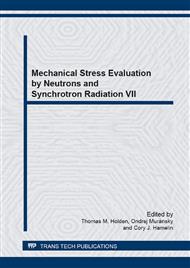[1]
A. Orsolini and J. D. Booker, "Modelling Capabilities Required for the Double Nosing Process in the Assembly of Spherical Plain Bearings," in Proceedings of the Institution of Mechanical Engineers, Part B: Journal of Engineering Manufacture, 2012, p.226–930.
DOI: 10.1177/0954405411434679
Google Scholar
[2]
J. Woodhead and J. D. Booker, "Modelling of Nosing for the Assembly of Aerospace Bearings," in Experimental and Applied Mechanics, Volume 4, 2013, p.327–337.
DOI: 10.1007/978-1-4614-4226-4_38
Google Scholar
[3]
S. Reid and J. Harrigan, "Transient Effects in the Quasi-static and Dynamic Internal Inversion and Nosing of Metal Tubes," Int. J. Mech. Sci., vol. 40, no. 2–3, p.263–280, 1998.
DOI: 10.1016/s0020-7403(97)00054-4
Google Scholar
[4]
W. C. Young and R. G. Budynas, Roark's Formulas for Stress and Strain, Seventh. New York: McGraw-Hill, 2002, p.851.
Google Scholar
[5]
Budynas-Nisbett, Shigley's Mechanical Engineering Design, Eighth. New York: McGraw-Hill, 2008, p.1059.
Google Scholar
[6]
T. Y. Reddy, "Tube Inversion - An Experiment in Plasticity," Int. J. Mech. Eng. Educ., vol. 17, no. 4, p.277–291, 1989.
Google Scholar
[7]
"Standard Test Methods of Compression Testing of Metallic Materials at Room Temperture," vol. 2, no. 1. ASTM International, p.1–10, 2010.
Google Scholar
[8]
M. E. Fitzpatrick and A. Lodini, Analysis of Residual Stress by Diffraction using Neutron and Synchrotron Radiation. New York: Taylor & Francis, 2003, p.354.
DOI: 10.1201/9780203608999
Google Scholar
[9]
"Non-destructive Testing — Standard Test Method for Determining Residual Stresses by Neutron Diffraction," vol. 3. British Standards (BSi), 2008.
DOI: 10.3403/30372102
Google Scholar
[10]
M. T. Hutchings, P. J. Withers, T. M. Holden, and T. Lorentzen, "Interpretation and Analysis of Lattice Strain Data," in in Introduction to the Characterization of Residual Stress by Neutron Diffraction, Illustrate., Boca Raton: CRC Press, 2005, p.203–262.
DOI: 10.1201/9780203402818.ch5
Google Scholar
[11]
J. D. Booker and C. E. Truman, "A Statistical Study of the Coefficient of Friction under Different Loading Regimes," J. Phys. D. Appl. Phys., vol. 41, no. 17, p.1–12, 2008.
DOI: 10.1088/0022-3727/41/17/174003
Google Scholar
[12]
R. G. Narayanan, M. R. Mitchell, R. E. Link, M. Gopal, and A. Rajadurai, "Influence of Friction in Simple Upsetting and Prediction of Hardness Distribution in a Cold Forged Product," J. Test. Eval., vol. 36, no. 4, p.1–13, 2008.
DOI: 10.1520/jte101443
Google Scholar
[13]
Y. Huang, Y. Lu, and M. Chen, "Analyzing the Cold-nosing Process Using Elasto-plastic and Rigid-plastic Methods," J. Mater. Process. Technol., vol. 30, p.351–380, 1992.
DOI: 10.1016/0924-0136(92)90226-i
Google Scholar
[14]
T. Kuboki, Y. Ohde, and M. Murata, "Improvement of Forming Limit by Rotary Nosing with a Relieved Die," Proc. Inst. Mech. Eng., vol. 222, p.245–253, 2008.
DOI: 10.1243/09544054jem852
Google Scholar
[15]
Y. Lu, "Study of Preform and Loading Rate in the Tube Nosing Process by Spherical Die," J. Comput. Methods Appl. Mech. Eng., vol. 194, p.2839–2858, 2005.
DOI: 10.1016/j.cma.2004.07.032
Google Scholar
[16]
K. Manabe and H. Nishimura, "Nosing of Thin-walled Tubes by Circular Curved Dies," J. Mech. Work. Technol., vol. 10, p.287–298, 1984.
DOI: 10.1016/0378-3804(84)90044-5
Google Scholar
[17]
M. Tang and S. Kobayashi, "An Investigation of the Shell Nosing Process by the Finite-Element Method. Part 1: Nosing at Room Temperature (Cold Nosing)," J. Eng. Ind., vol. 104, no. 82, p.305–311, 1982.
DOI: 10.1115/1.3185834
Google Scholar


